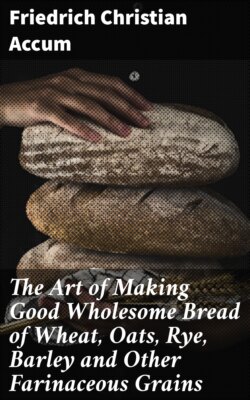Читать книгу The Art of Making Good Wholesome Bread of Wheat, Oats, Rye, Barley and Other Farinaceous Grains - Friedrich Christian Accum - Страница 5
HISTORICAL SKETCH
OF
THE ART OF MAKING BREAD.
ОглавлениеNothing appears so easy at first sight, as to grind corn, or other farinaceous substances, to knead the flour with water into dough, and to convert it, by baking, into porous bread. But, simple as these operations may now appear to us, the art of making loaf-bread was by no means one of the earliest among human inventions.
For, however essential this species of food may be considered among us as an article of primary subsistence, it is perfectly certain, that men had long existed in a state of civilization, before bread was known among them.
It is evident that every species of corn must have been originally the spontaneous production of the earth; but as the grain, previous to cultivation, would grow but scantily, its importance as food might long escape observation, and mankind would naturally derive a more obvious, though less nutritive subsistence, from acorns, berries, and other fruits which were within their reach. Ages elapsed ere Ceres, according to the Grecian mythology, descended from heaven to teach mankind the use of agriculture.
In the early ages of society, according to some historians, men were satisfied with parching their corn for immediate use as food. The next advance appears to have been, to pulverize the grain in a mortar or handmill, and to form it, by the addition of water or milk, into a kind of porridge; or to make the bruised grain into dough, which was rendered eatable by baking on embers.
Even after the method of grinding corn into meal, and separating the bran by sifting, had become known, it was long before the art of fermenting the dough, in order to produce bread full of eyes and of a soft consistence, was discovered.
Like most other operations of primary importance, the origin of the art of making bread is lost in the darkness of ages past.
We are, however, certain that the Jews practised this art in the time of Moses; for we find in the Book of Exodus, chap. xii. v. 18, a prohibition to make use of leavened, that is, fermented bread, during the celebration of the Passover. But it does not appear that loaf-bread was known to Abraham, for in his history we read frequently of cakes, but not of fermented bread. It is, therefore, very probable, that the art of making fermented bread took its rise in the East, and that the Jews learned it from the Egyptians.
The Greeks attribute the art of making bread to the god Pan.
Bakers were unknown in Rome till the year of the city 850, or about 200 years before the Christian era. The Roman bakers, according to Pliny, came from Greece with the Macedonian army. Before this period, the Romans were often distinguished by the appellation of eaters of pap.
At the time of Augustus, there were upwards of 300 baking houses in Rome, almost the whole of which were occupied by Greeks. The bakers enjoyed in ancient Rome great privileges. The public granaries were entrusted to their care; they formed a corporation, or kind of college, from which neither they nor their children were permitted to withdraw. They were exempted from guardianships and public services, which might interfere with their occupation. They were eligible to become Senators; and those who married the daughters of bakers, became members of the college.
From the establishment of bakers in Rome, the art of making loaf, or fermented bread, spread amongst the ancient Gauls; but its progress in the northern countries of Europe was slow, and in some northern districts, the luxury of eating fermented, or loaf-bread, is at this day not in general use. Some of the modern Italians consume the greatest part of their bread-flour in the state of macaroni and vermicelli, and in other forms of polenta, or soft pudding; and even at present millions of people neither sow nor reap, but content themselves with enjoying the spontaneous productions of the earth.
